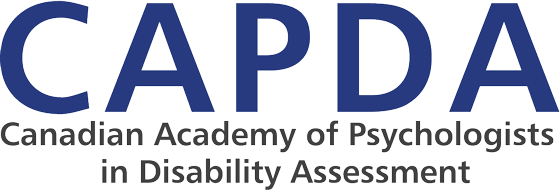Purchase Video Access - DSM 5: Overview, Critique, Recommendations
Date
Friday, June 21, 2013
Location
Main Dining Room91 King Street East
Toronto, ON
8AM - 4PM
Registration Details
Exclusive Content is Now Available to those who attended the Workshop.Log in using your account name and password, click on Resources, Exclusive Workshop Content.
Note: You will receive a copy of the submitted form to the email you provide below.
FEES
- Video Access Fess
$100.00 (Non-Members) - $75.00 (Members)
- $50.00 (Student Rate)
- Once Registered please pay online (via Paypal) or mail your Cheque to:
Carol FordCAPDA
312 Oakwood Court
Newmarket, Ontario
L3Y 3C
| Pay Securely via PayPal | |
| $100.00 (Non-Member) |  |
| $75.00 (Member) |  |
| $50.00 (Student) |  |
Description

The Workshop which was held at The Albany Club (91 King St. E., Toronto, ON) on June 21, 2013 is now available for purchase.
The DSM 5 was officially published in May, 2013, after rancorous criticism of the procedures used, the draft versions, and the final product, with equally vigorous defence at all these levels. The manual should reflect practitioner utility requirements and scientific reliability and validity requirements. However, on both these grounds, the manual has been attacked. Moreover, unlike the case for the working groups for the prior version, the DSM-IV (1994, 2000), the procedure was not open and there were accusations of conflicts of interest, e.g., with pharmaceutical companies. Finally, for present purposes, the manual has been criticized for its lack of careful vetting for forensic applications.
Speaker(s)
Gerald Young, Ph.D., C.Psych.
Gerald Young, Ph.D., C. Psych., is an Associate Professor in the Department of Psychology at Glendon College, York University, Toronto, Canada. In addition, he is a practicing psychologist. He is the sole author or senior editor/ co-author of five books, the most recent on malingering (Malingering, Feigning, and Response Bias in Psychiatric/ Psychological Injury - Implications for Practice and Court published by Springer SBM, New York, 2013). For the area of psychological injury and law, he is the first to have organized (a) a scientific association [www.asapil.net], (b) an academic journal [Psychological Injury and Law [PIL, springer.com], and (c) integrative books on the topic (2006, 2007). His other areas of research include child development (Development and Causality: Neo-Piagetian Perspectives, Springer, 2011) and the DSM 5 (co-editing a 2010 PIL special issue on the topic and another upcoming in 2013 or 2014).
Learning Objectives
General Introduction to DSM 5
The DSM 5 was officially published in May, 2013, after rancorous criticism of the procedures used, the draft versions, and the final product, with equally vigorous defence at all these levels. The manual should reflect practitioner utility requirements and scientific reliability and validity requirements. However, on both these grounds, the manual has been attacked. Moreover, unlike the case for the working groups for the prior version, the DSM-IV (1994, 2000), the procedure was not open and there were accusations of conflicts of interest, e.g., with pharmaceutical companies. Finally, for present purposes, the manual has been criticized for its lack of careful vetting for forensic applications.
Learning Objectives
- To be able to list the major changes in the DSM 5 from the DSM-IV.
- To be able to describe the major criticisms of the DSM 5.
- To be able to discern the implications of the changes and criticisms for your practice
Psychological Injury Categories
Some of the new categories proposed might not have been carefully thought through, while others were kept intact, and might reflect the same lack of careful thought. Some categories lower the bar in diagnosing disorder while others raise it. Children appear unduly targeted, with ease in diagnosing some disorders and the consequent spectre raised of overmedicating them. Two categories of special concern to CAPDA are PTSD and pain disorder. The changes wrought for these two categories will be reviewed carefully and the implications of the changes will be discussed, e.g., for PTSD tests, for giving a diagnosis that makes sense for pain patients. Another category of concern is neurocognitive disorder, e.g., in TBI. The changes in it will be discussed in dialogue with the neuropsychologists the audience.
Learning Objectives
- Describe the major changes for PTSD.
- Describe the major changes for pain disorder.
- Describe the major changes for neurocognitive disorder
Discussion & Recommendations
Another dialogue should take place about what the changes mean for practice in rehabilitation and assessment. and tort, and workers compensation, this time with the full audience. I will contend that the changes in the DSM 5 will open psychologists to criticisms by both plaintiff and defence attorneys, and even arbitrators/judges. The best manner in hedging these criticisms is to adopt a functional approach in evaluations, and not relying on specific diagnostic labels as primary, which is the normative approach in good practice in the field already. To conclude, I will describe some recent research on psychopathology and nosology (e.g., systems, endophenotypes) that go beyond even the traditional psychologists’ contention that the DSM should be more dimensional than categorical. The DSM should become a manual under constant scrutiny and revision according to state of the art science in the field.
Learning Objectives
- Realize the implications for rehab/disability, and tort/workers compensation practice.
- Develop tactics to handle assessments and court despite flaws in the manual.
- Follow recommendations for changing the manual and recent research in the area.
Resources
()CAPDA - DSM 5 - Overview Critique Recommendations Workshop (June 21, 2013)CPA Continuing Education Program Credited Workshop

